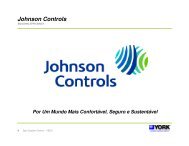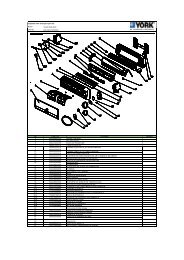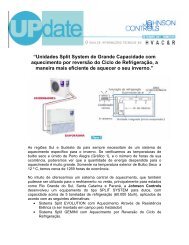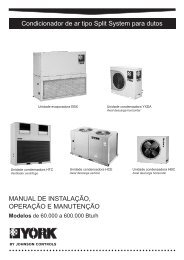Manual Técnico - Chiller YORK® Absorção YPC ... - Johnson Controls
Manual Técnico - Chiller YORK® Absorção YPC ... - Johnson Controls
Manual Técnico - Chiller YORK® Absorção YPC ... - Johnson Controls
You also want an ePaper? Increase the reach of your titles
YUMPU automatically turns print PDFs into web optimized ePapers that Google loves.
FORM 155.17-EG4<br />
Available Draft (Da) – The Available Draft is the draft<br />
required at the outlet exhaust flange of the YORK High<br />
Temperature Generator.<br />
Pressure Drop (dP) – Frictional losses in the chimney<br />
system which act against theoretical draft. The chimney<br />
draft needed to overcome chimney frictional losses<br />
is described as follows:<br />
Dt = dP + Da<br />
Proper chimney design balances the theoretical draft<br />
(Dt) against the pressure drop (dP) of the chimney system<br />
in order to provide the required available<br />
pressure(Da) at the outlet of the chiller-heater.<br />
Proper chimney design must provide the required (Da)<br />
under all operating conditions. Because the difference<br />
between summer and winter ambient conditions can result<br />
in Dt variations of 50% and greater, some method of<br />
draft control is usually required in order to maintain Da.<br />
Chimney Application – The YORK direct-fired chillerheater<br />
is equipped with a forced draft burner capable of<br />
firing on a variety of fuels, including natural gas and/or<br />
No. 2 oil and/or propane. As such, the unit will require a<br />
properly designed chimney system to control draft and<br />
discharge flue gases from the unit to the atmosphere.<br />
The combustion chamber of the chiller-heater is engineered<br />
to product a positive gauge pressure of 0.05 to<br />
0.15 in. of water (1.27 - 3.81 kg/m 2 ) at the outlet of the<br />
first stage generator with an exhaust temperature of<br />
400°F+/-50°F (204°C +/- 28°C). As such the chimney<br />
design must provide a method for maintaining the pressure<br />
at all ambient conditions. Because YORK<br />
chiller-heaters operate at “high fire” throughout the summer<br />
months, it is important to design the chimney system<br />
for summer ambient design conditions to avoid<br />
undersizing. It is recommended that the chimney itself<br />
should be designed for a Da of 0 (zero) in. (0 mm) of<br />
water column. This will prevent the chimney from becoming<br />
pressurized at any point along the flue gas path.<br />
Caution – If the stack/chimney pressure is ever<br />
above 0 (zero) in. of water column there<br />
is a chance of flue gas being leaked<br />
into the equipment room.<br />
There are two commonly used ways to maintain the<br />
pressure at the outlet of the chiller-heater. Either manual<br />
or automatic/motorized draft control can be used. All<br />
YORK direct-fired chiller-heaters will come standard with<br />
a manual draft control damper. This damper can be modified<br />
for motorized operation either in the factory (if ordered)<br />
or in the field if site conditions require.<br />
<strong>Manual</strong> Draft Control – <strong>Manual</strong> draft control is suitable<br />
for applications where each gas fired appliance will have<br />
its own dedicated chimney and draft control system. Fig.<br />
7 depicts a simple yet effective means of controlling draft.<br />
YORK INTERNATIONAL<br />
With this system, a (field supplied) barometric draft regulator<br />
is used in series with the factory supplied manual<br />
backdraft damper. With maximum economy employed<br />
in the chimney design, Dt would exactly equal dP + Da<br />
during the summer design ambient conditions with the<br />
barometric regulator closed. In reality, some degree of<br />
conservatism should exist in the design, causing the<br />
barometric regulator to be open slightly even during<br />
summer design conditions. As ambient temperatures<br />
drop, Dt would increase, if not for the barometric draft<br />
regulator. With the regulator in place, mechanical room<br />
air is introduced into the chimney system in response<br />
to the impressed draft, thus stabilizing the gauge pressure<br />
just upstream of the barometric regulator. Most<br />
barometric regulators can maintain -0.06 in. water column<br />
gauge pressure when properly sized for a particular<br />
application.<br />
With the gauge pressure stabilized upstream of the barometric<br />
regulator, the factory supplied manual backdraft<br />
damper can be adjusted to a fixed position which will<br />
provide the pressure drop to yield the required positive<br />
pressure at the exhaust flange of the chiller-heater.<br />
Motorized Draft Control – Motorized draft control is suitable<br />
for applications where multiple gas fired appliances<br />
will be ducted into one common chimney system. In this<br />
case each unit will require its own draft control system.<br />
(Motorized draft control may be used for one chiller-heater/one<br />
chimney applications as well if it is desired<br />
over manual control.) Fig. 8 depicts a sequential<br />
draft control system which incorporates a motorized<br />
damper whose position is automatically adjusted as a<br />
function of available draft at the outlet of the chiller. The<br />
YORK supplied backdraft damper at the outlet of the<br />
chiller can be modified (in the factory if ordered, or in<br />
the field) to mount the motor driver. The motor is controlled<br />
from a draft control panel which senses the pressure<br />
at the outlet of the chiller-heater. The draft control<br />
panel is available from YORK to ship with the chiller.<br />
The panel is wired to the burner panel and damper motor<br />
in the field, and the pressure is sensed through a small<br />
line field connected to the outlet of the chiller-heater.<br />
Special Problems and Maintenance – Factors causing<br />
draft variations during normal operation include: wind<br />
and weather factors, inadequate chimney construction<br />
or system installation, location of installation, or inadequate<br />
system maintenance.<br />
Wind and weather – Windy conditions will tend to increase<br />
the draft in the chimney as the wind helps to<br />
remove the combustion products leaving the chimney<br />
at a much faster rate. Down draft may occur causing a<br />
temporary positive pressure in the chimney system. The<br />
stack should be designed to prevent not only wind, but<br />
21


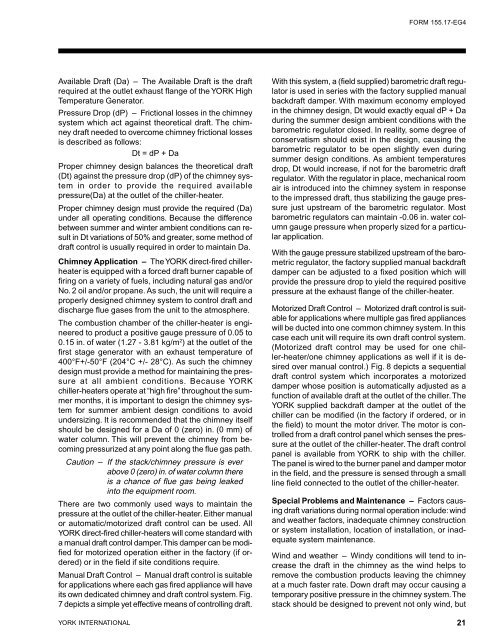
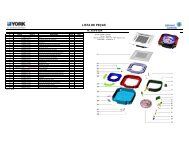

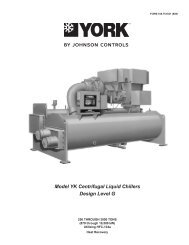
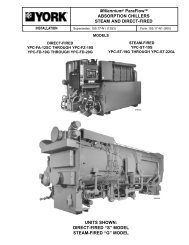
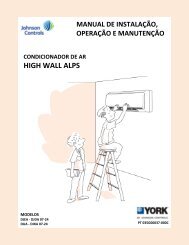
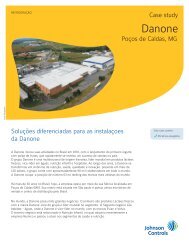


![[PDF] Catálogo Técnico YP Corrigido Corel 9 - Johnson Controls](https://img.yumpu.com/49244478/1/190x245/pdf-catalogo-taccnico-yp-corrigido-corel-9-johnson-controls.jpg?quality=85)

